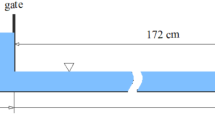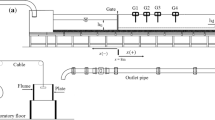Abstract
The role of turbulence is investigated in dam-break flows, where a finite volume of fluid is released from a compartment into a long, rectangular channel. After a sudden removal of the lock gate, a gravity current, undular bore, or solitary wave develops, depending on the ambient fluid height in the channel. The temporal evolution of the moving front has been measured and evaluated. It was observed that the dilution using a very small amount (a few weight ppm) of a long chain polymer (polyethylene-oxide) in the fluid strongly affected flow properties. Pronounced drag reduction has been found in dry bed flows (whereas the polymer increased the viscosity of the fluid). The presence of a few mm-thick ambient fluid layer in the channel effectively destroyed drag reduction, in spite of the fact that strong turbulence was obvious and the propagation velocity of the front was almost unchanged.















Similar content being viewed by others
References
Benzi R, Ching ESC, Horesh N, Procaccia I (2004) Theory of concentration dependence in drag reduction by polymers and of the maximum drag reduction asymptote. Phys Rev Lett 92.078302
Berman NS (1978) Drag reduction by polymers. Annu Rev Fluid Mech 10:47–64
Boffetta G, Celani A, Musacchio S (2003a) Two-dimensional turbulence of dilute polymer solutions. DOI 10.1103/PhysRevLett.91.034501
Boffetta G, Celani A, Mazzino A (2003b) Onset and universality of drag reduction in turbulent Kolmogorov flow. lanl.arXiv.org:nlin-0309036
Brannan DA, Esplen M, Gray J (1999) Geometry. Cambridge University Press, Cambridge
Bushnell DM (1991) Drag reduction in nature. Annu Rev Fluid Mech 23:65–79
Cadot O, Bonn D, Douady S (1998) Turbulent drag reduction in a closed flow system: Boundary layer vs bulk effects. Phys Fluids 10:426–436
Clever RM, Busse FH (1992) Three-dimensional convection in a horizontal fluid layer subjected to a constant shear. J Fluid Mech 234:511–527
Clever RM, Busse FH (1997) Tertiary and quaternary solutions for plane Couette flow. J Fluid Mech 344:137–153
De Angelis E, Casciola CM, L’vov VS, Piva R (2003) Drag reduction by polymers in turbulent channel flows: Energy redistribution between invariant empirical modes. DOI 10.1103/PhysRevE.67.056312
Eckhardt B, Faisst H, Schmiegel A, Schumacher J (2002) Turbulence transition in shear flows. In: Castro IP, Hancock PE, Thomas TG (eds) Advances in Turbulence IX, proceedings of the 9th European turbulence conference, CIMNE, Barcelona, Spain, 2002, pp 1–8
Gampert B, Wagner P (1985) The influence of molecular weight and molecular weight distribution on drag reduction and mechanical degradation in turbulent flow of highly dilute polymer solutions. In: Gampert D (ed) Proceedings of the IUTAM symposium on the influence of polymer additives on velocity and temperature fields, Essen, Germany, June 1984, pp 71–85
Gröbelbauer HP, Fanneløp TK, Britter RE (1993) The propagation of intrusion fronts of high density ratios. J Fluid Mech 250:669–687
Gyr A, Bewersdorff HW (1995) Drag reduction of turbulent flows by additives. Kluwer Academic Publ, Dordrecht
Housiadas KD, Beris AN (2003) Polymer-induced drag reduction: Effects of the variations in elasticity and inertia in turbulent viscoelastic channel flow. Phys Fluids 15:2369–2384
Huppert HE (1982) The propagation of two dimensional and axisymmetric viscous gravity currents over a rigid horizontal surface. J Fluid Mech 121:43–58
Klemp JB, Rotunno R, Skamarock WC (1997) On the propagation of internal bores. J Fluid Mech 331:81–106
Kondic L (2003) Instabilities in gravity driven flow of thin fluid films. SIAM Rev 45:95–113
L’vov VS, Pomyalov A, Procaccia I, Tiberkevich V (2003) Drag reduction by polymers in wall bounded turbulence. lanl.arXiv.org:nlin-0307034
Lumley JL (1969) Drag reduction by additives. Annu Rev Fluid Mech 1:367–384
Min T, Yoo JY, Choi H, Joseph DD (2003a) Drag reduction by polymer additives in a turbulent channel flow. J Fluid Mech 486:213–238
Min T, Choi H, Yoo JY (2003b) Maximum drag reduction in a turbulent channel flow by polymer additives. J Fluid Mech 492:91–100
Nagata M (1990) Three-dimensional finite-amplitude solutions in plane Couette flow: Bifurcation from infinity. J Fluid Mech 217:519–527
Paireau O, Bonn D (1999) Drag reduction in liquid-liquid friction. Phys Rev Lett 83:5591–5594
Ptasinski PK, Boersma BJ, Nieuwstadt FTM, Hulsen MA, Van den Brule BHAA, Hunt JCR (2003) Turbulent channel flow near maximum drag reduction: simulations, experiments and mechanisms. J Fluid Mech 490:251–191
Ritter A (1892) Die Fortpflanzung der Wasserwellen. Zeitschrift des Vereines Deutscher Ingenieure 36:947–954
Schmiegel A, Eckhardt B (1997) Fractal stability border in plane Couette flow. Phys Rev Lett 79:5250–5253
Schmiegel A, Eckhardt B (2000) Persistent turbulence in annealed plane Couette flow. Europhys Lett 51:395–400
Simpson JE (1997) Gravity currents: In the environment and laboratory. Cambridge University Press, Cambridge
Sreenivasan KR, White CM (2000) The onset of drag reduction by dilute polymer additives, and the maximum drag reduction asymptote. J Fluid Mech 409:149–164
Stansby PK, Chegini A, Barnes TCD (1998) The initial stages of dam-break flow. J Fluid Mech 374:407–424
Stone PA, Waleffe F, Graham MD (2002) Toward a structural understanding of turbulent drag reduction: Nonlinear coherent states in viscoelastic shear flows. Phys Rev Lett 89:208301–1-4
Stone PA, Graham MD (2003) Polymer dynamics in a model of the turbulent buffer layer. Phys Fluids 15:1247–1256
Sturm TW (2001) Open channel hydraulics. McGraw-Hill Science, New York
Toms BA (1949) Observation on the flow of linear polymer solutions through straight tubes at large Reynolds numbers. In: Proceedings of the international rheological congress, Amsterdam, North Holland, II-135–141
Virk PS (1975) Drag reduction fundamentals. AIChE J 21:625–656
Acknowledgements
This work was supported by the Hungarian Science Foundation (OTKA) under Grant Nos. T032423, T032437, and TS044839. The authors are thankful to Gyözö Láng for his assistance in physical-chemical measurements.
Author information
Authors and Affiliations
Corresponding author
Rights and permissions
About this article
Cite this article
M. Jánosi, I., Jan, D., Szabó, K.G. et al. Turbulent drag reduction in dam-break flows. Exp Fluids 37, 219–229 (2004). https://doi.org/10.1007/s00348-004-0804-4
Received:
Accepted:
Published:
Issue Date:
DOI: https://doi.org/10.1007/s00348-004-0804-4




